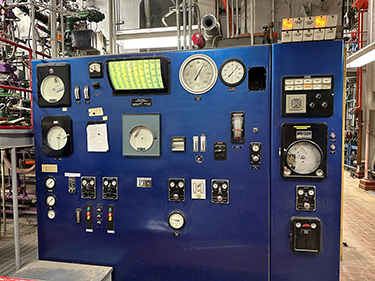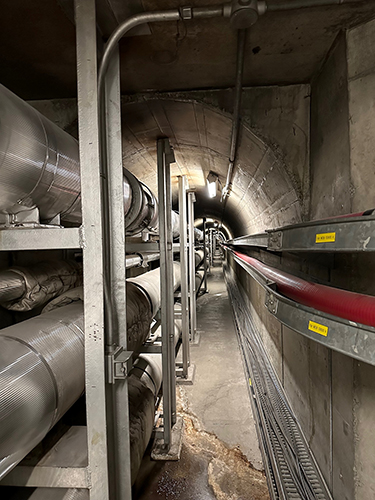|
Subscribe / Renew |
|
|
Contact Us |
|
| ► Subscribe to our Free Weekly Newsletter | |
| home | Welcome, sign in or click here to subscribe. | login |
Environment
| |
 |
April 25, 2024
A primer on campus decarbonization in Washington
Affiliated Engineers Inc.

Keck
|
Campus property owners are currently faced with a confluence of codes and regulations, forcing them to think holistically about decarbonizing their buildings and campus infrastructure. “Decarbonization” is a broad term for reducing the greenhouse gas emissions (GHG) associated with operational energy use, goods and services used by an institution, and the embodied carbon of materials. This article will only focus on the energy side of decarbonization.
In Washington state, energy codes are restricting or banning the use of fossil fuels for space heating and domestic water heating and mandating renewable energy generation. The Washington Clean Buildings Performance Standard (CBPS) and the Seattle Building Emissions Performance Standard set mandatory energy use and GHG emission limits respectively for existing commercial buildings. Washington House Bill 1390 will mandate district energy system decarbonization under CBPS. New equipment that uses refrigerants with a global warming potential greater than 750 is now restricted for sale in Washington. Additionally, institutions may have their own set of public commitments to uphold related to carbon emissions reduction and environmental stewardship.
Campus property owners must strategize solutions to plan, fund and successfully execute work that aligns with the common goal of campus decarbonization while being coordinated across many project types such as new construction, existing buildings, and utility infrastructure modernization.
PROJECT VISION AND DELIVERY
Transitioning a campus away from fossil fuel energy sources is an enormous endeavor that begins with planning, followed by implementation, and finally by design and execution.
Planning stages commence with assessment of existing campus infrastructure and consider all potential solutions available given the site and building portfolio. Understanding campus load growth and leveraging deferred maintenance toward the unified goal of decarbonization are common. The outcome of the planning stage is a preferred path forward that considers how this new solution compares to business-as-usual levels of maintenance and reinvestment needed to maintain operations with existing infrastructure.
With a feasible concept of how to decarbonize the campus, the implementation phase furthers the planning effort with more detailed engineering and cost analysis, project scoping and phasing, delivery method assessment, and funding plan. Finally, the numerous phased projects are executed in strategic order with full design, construction, commissioning and verification.
Collaboration is crucial to developing and executing a campus decarbonization effort that may be decades in the making. Shared values and consensus building promote accountability among all stakeholders. Detailed documentation of decision-making enables the plan to be durable through changes in leadership and evolving constraints. Collaboration occurs on many levels, starting with the owner’s internal groups such as capital planning, design and construction, facilities engineering and operations, and executive leadership. Additional opportunities are unlocked when an owner collaborates early and often with utility providers and other community partners. When executing the plan, designers and builders must also work together to deliver the entire project successfully.
TECHNICAL APPROACH
Campus decarbonization begins with efforts at the building level to minimize peak loads and annual energy consumption through demand reduction and passive design strategies. These projects improve building energy efficiency relative to compliance targets and reduce the cost of transitioning major infrastructure to support peak design heating, cooling, and electrical loads. Example strategies may include retro-commissioning, building envelope improvements, lighting retrofits, solar control and passive heating, occupant-scale comfort solutions, energy recovery, and intelligent controls for lighting, equipment, ventilation, and space conditioning.
Energy-efficient and low-carbon active systems are applied next to further reduce energy consumption and transition toward clean energy sources. This often boils down to a move away from fossil fuel combustion for space heating and domestic water heating toward heat pump—based technology powered by electricity sources that become renewable and more resilient over time. Consideration must also be given to specialty systems in buildings such as foodservice, domestic or laboratory water heating, humidification, sterilization, and other process needs that traditionally run on natural gas.
Many campus property owners have existing district energy systems (DES) that supply central heating, cooling, or heating and cooling through a distributed system to multiple buildings via steam, heating water, or cooling water. Often the DES heating provided to buildings comes from steam generated by natural gas boilers. These legacy systems are gravely inefficient and often produce most GHG emissions associated with operational energy in the campus environment. Transitioning steam DES to a lower-temperature hot water system allows a wide range of thermal energy sources to contribute to campus heating and significantly reduces energy loss inherent to lengthy steam and condensate return piping.
When approaching a steam-to-hot water transition, it’s helpful to group the efforts into three main “buckets:” building conversion, distribution network, and central plant equipment.
BUILDING CONVERSION
Building conversion takes building-level systems that currently operate on steam and/or high-temperature heating water and modernizes them to run on lower-temperature heating water. This may include legacy systems such as steam radiators, steam heating coils in air handlers, or a heating water system that is designed for 180°F. While its possible for steam or high-temperature heating water to be produced from low-carbon electricity, it may come with the tradeoff of poor energy efficiency, high operational cost and reliability concerns with unproven applications.
Building conversion work is often the most expensive element of decarbonizing a campus DES because the work is vast, uncertain, and detail driven. This high degree of risk impacts cost, schedule, and the need for unique solutions to be developed based on the particulars of each building’s existing systems, space constraints, and operational needs.
THERMAL DISTRIBUTION NETWORK
The second bucket to consider is the thermal distribution network, which may include new heating, cooling, or condenser water distribution to buildings. Existing utility tunnels provide a conduit to buildings; however, it may not be possible to run new piping without first decommissioning existing steam and condensate piping (for which timing can become a challenge).
New utility tunnels provide long-term benefits with high first cost. Direct-bury options are attractive for many campus clients from a first cost standpoint, but require careful attention to material selection, routing, and accessibility at key intervals.
Distribution is often the second most expensive element for a campus DES decarbonization effort. It’s important to plan and execute the work one time (avoiding disruption of the same location in short succession) and foster an agile team that responds to unforeseen field conditions efficiently. Additional win-win opportunities, such as campus pathway and ADA improvements, are a positive outcome of sitework.
CENTRAL PLANT EQUIPMENT
The final bucket includes modernization of centralized primary generation equipment. Potential sources of thermal energy on the campus are explored, including geothermal exchange, building waste heat, air-source heat pumps, solar thermal systems, and sewer water heat exchange. Thermal energy storage extends the duration of simultaneous heating and cooling production while providing benefits of peak load reduction, utility cost optimization, and improved resiliency.
The most reliable, practical and lifecycle cost-efficient solutions typically involve a mix of right-sized and right-applied technologies at the building or district scale. This often includes electric heat pumps, thermal energy storage and “peaking” equipment (such as electric or natural gas boilers) that handle infrequent peak loads in the most first-cost efficient and operationally reliable manner. A fossil fuel “backbone” system may be maintained to provide resiliency, peak heating and to serve process loads during the full transition. Lastly, early and open communication with electric utility providers is paramount with campus scale electrification.
Campus property owners are rising to the challenge of carbon emission reduction and strategically planning, funding and executing long-term campus decarbonization projects to move away from fossil fuels toward clean and renewable energy infrastructure.
Lyle Keck is building performance practice leader at Affiliated Engineers Inc.
Other Stories:
- Creativity and innovation are hallmarks of sustainability at PDX Airport
- Curbing construction’s carbon impact from all angles
- Making old buildings new again: the case for adaptive reuse
- Promoting residential adaptive reuse in Seattle through policy
- Hiding in Plain Sight: Sustainability and resilience beyond the terminal
- Reducing embodied carbon in concrete construction
- Old building, new tricks: Designing adaptive reuse for long-lasting relevance
- Harnessing the potential of mixed-use communities
- Implementing aggressive water goals
- A blueprint for environmental responsibility in construction
- Toward a path to zero carbon: building renovations and circular economy principles




